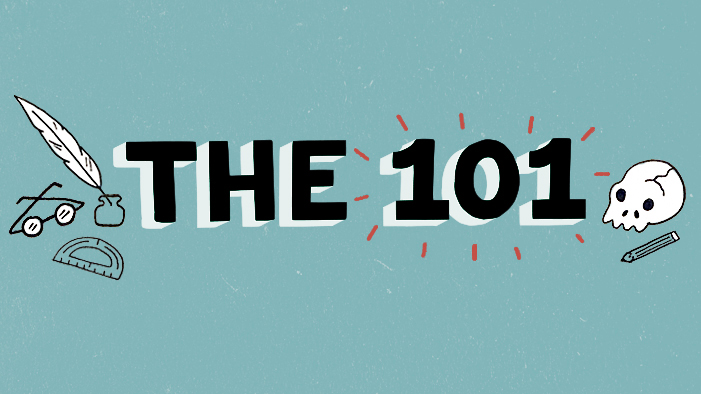The 101: A Step-by-Step Guide to Writing a College Lit Paper

Welcome to The 101, a new series where we give you the quick-and-dirty on some essential school skills, from analyzing poems and short stories to identifying unreliable narrators! First up, tackling the dreaded lit paper! —ed.
I walked into my first college English class smug and self-assured—twelve years of five-paragraph essays and I thought I had it down. It was simple: an intro, three body paragraphs (to the tune of, “My first point is…,” “My second point is …”), and a conclusion that basically repeated the intro word for word. I tuned out during my professor’s warning that writing in college was different and I pumped out the lame essay form I was used to. I got a C. I had no idea what a college-level paper looked like, let alone how to write one, and I drowned my sorrows in Netflix and Ben and Jerry’s. Eventually I figured it out through trial and error, but trial and error’s overrated. Here’s the eight-step essay-writing guide I wish someone had given freshman me.
1) Do a close reading
This is something I’d heard about in high school but never really understood. A good close reading is basically a bunch of solid observations about whatever you’re analyzing—whether it’s The Odyssey, The Great Gatsby, or your professor’s romance novella. There’s no point behind an initial close reading other than just noticing details, like images that get repeated, metaphors that stand out, or anything that catches your eye. Write out a list of everything you can (with page numbers!) and consider it your ammunition stash—it’ll come in handy later on.
2) Freewrite
Now that you’ve got literary thoughts swirling around your brain, it’s time to funnel them into coherent sentences. Keeping your essay prompt in mind, grab a blank sheet of paper, write It seems to me that . . ., and just go for five minutes. Try not to stop for anything—if you hit a dead end with one point, jump into another, and glance over at your ammunition stash if you need a springboard. The goal of all this is just one or two handwritten pages of ideas you’ll draw from in your paper—a “zero draft” that simply gets your mind on the page.
3) Come up with a thesis
This deserves its own post (To come! —ed.), but the long and short of a thesis is that it has to be an argument that passes the “so what?” test. Sure, you could say that Holden Caulfield is lonely, but that’s way less interesting than saying he’s hypocritical and a phony himself. (Not what I believe, but that’s exactly what makes it a thesis-worthy statement: it causes contention!) Look at your zero draft and highlight a couple ideas that could work together, and then write one focused argument about them. Think of your thesis as an entire six-page paper squeezed into one sentence. Here’s an example just so you can see the structure: Although Holden Caulfield expresses alienation by people he calls “phonies,” his own behavior and judgments make him the biggest phony of all. (It hurts me to write that, guys. Holden’s my boy.)
4) Outline, outline, outline
Come up with three or four solid points that support your thesis. Each of these should have a few pieces of text-based evidence behind it (remember your ammunition stash!), and will become a topic sentence. Type up an outline with your thesis at the top, each topic sentence with bullet points beneath it, and space for a conclusion. Once you’ve got the skeleton of your essay down on the page, the whole thing becomes less intimidating; you just have to fill in the meat.
5) Draft
Eventually, it’s time to really start. Write your body paragraphs by exploring each of your solid points one by one, drawing from your ammunition stash as much as possible. Don’t be afraid to let yourself have new ideas; after all, drafting is just another form of invention! By the end of this step, you’ll have a thesis and three paragraphs with topic sentences and text-based evidence. You’re well on your way to a complete first draft.
6) Edit like crazy
Re-read your draft and look for places where you repeat yourself or get distracted. Every point should lead back to your thesis, and the leaner your essay is, the meaner it’ll be. Reorganize your ideas if you have to, and smoothen out the transitions. This is when your paper will start to look and sound like an actual essay and not just a bunch of ideas slapped onto the page.
7) Revise
Come back to your thesis and ask yourself: is this still the point my essay is trying to make? Is anyone going to care? It’s never too late to change your thesis—in fact, I’d say the majority of the time it needs at least a little tweaking. Draft a conclusion that brings everything to an end (but doesn’t just repeat every point you’ve made), and finally, write an introduction that eases the reader into your thesis. Read through your completed draft a few times, fixing awkward spots and making sure it all makes sense.
8) Proofread (no, seriously, proofread)
College professors have no tolerance for typos or grammar errors. Trust me, I learned this one the hard way: run your computer’s spellcheck, bribe your roommate into reading it. Whatever it takes, never turn in a paper with mistakes you could’ve caught if you’d just spent an extra ten lousy minutes.
And that’s about it! The big difference between high school and college essay-writing is that you no longer have the five-paragraph model to fall back on, but now you’ve got something better: a chance to break the rules. As long as you have a clear thesis and your body paragraphs make good supporting points, you can go crazy. Argue that Odysseus is a villain! Throw in a one-sentence paragraph! Have fun and write something that will make your professor squirm, because I guarantee you, if you make strange arguments in smart ways, she’ll favor your paper over the dozens of boring five-paragraphers your classmates will turn in. So go out into the boring world of lit paper monotony and cause some trouble. Now you know how.
Are there any topics you’d like to see on The 101? Let us know!












